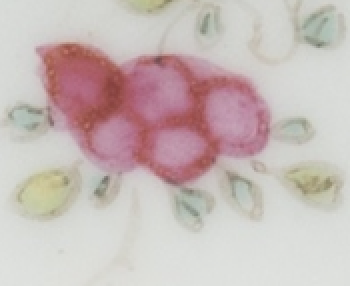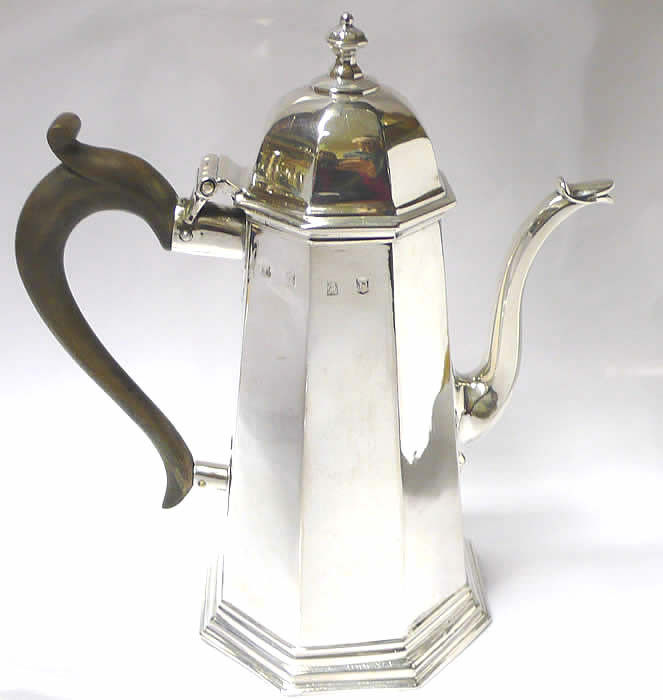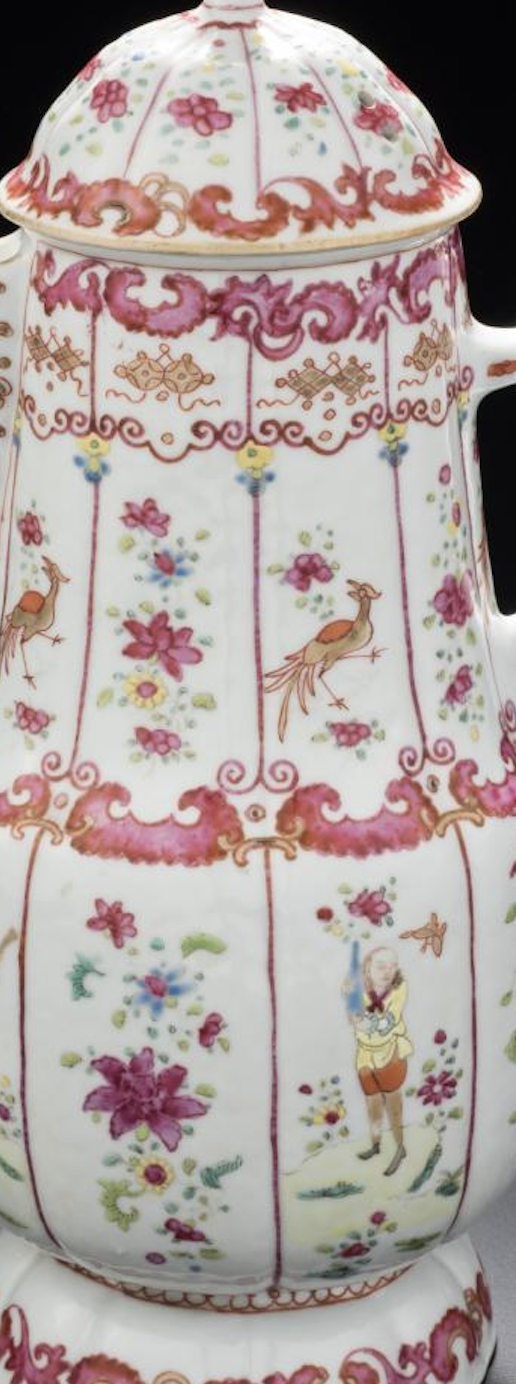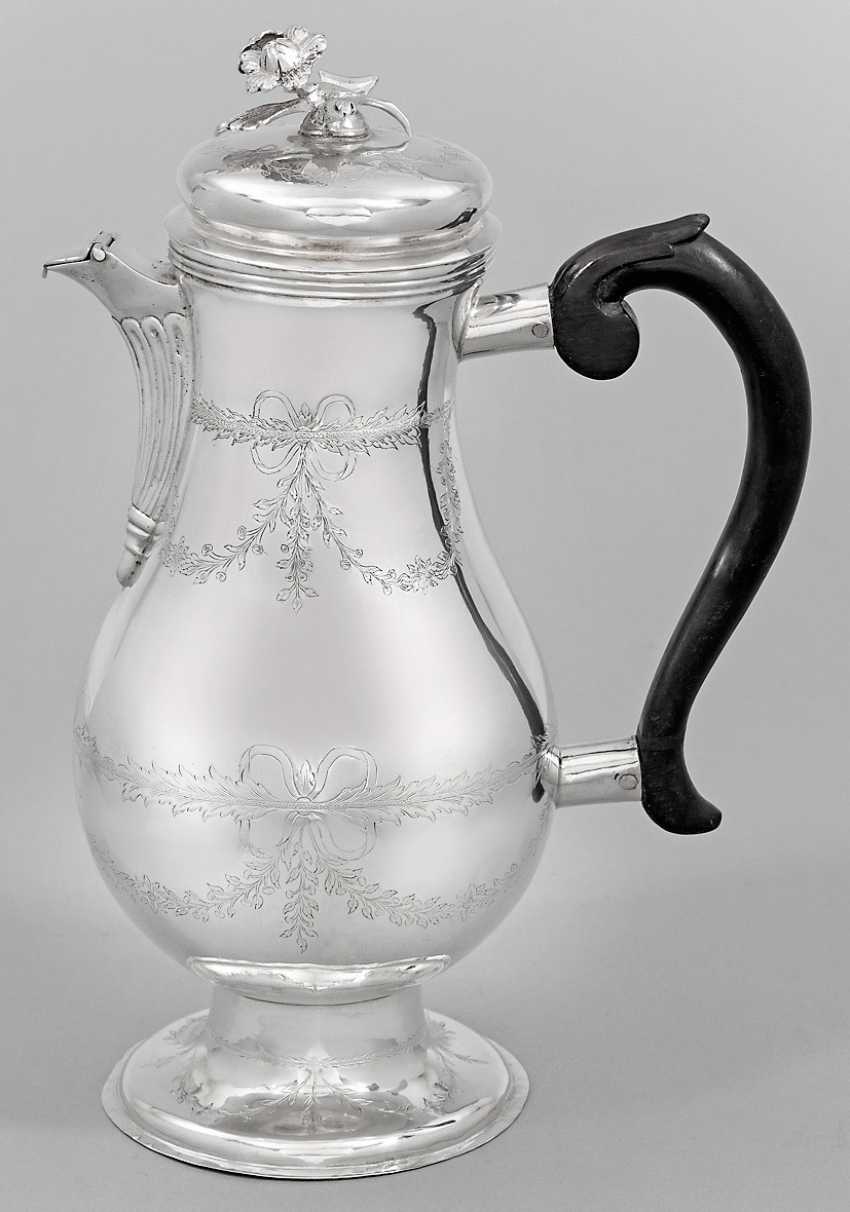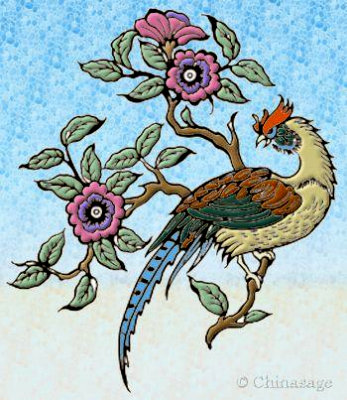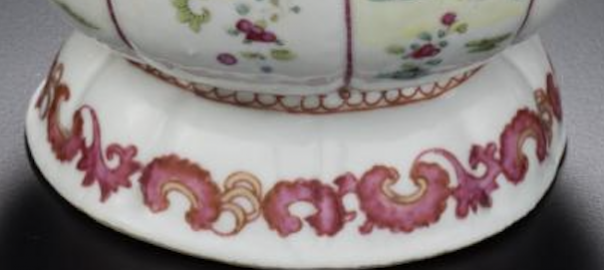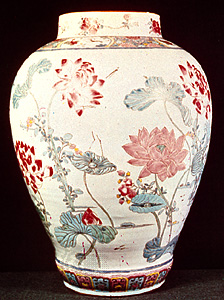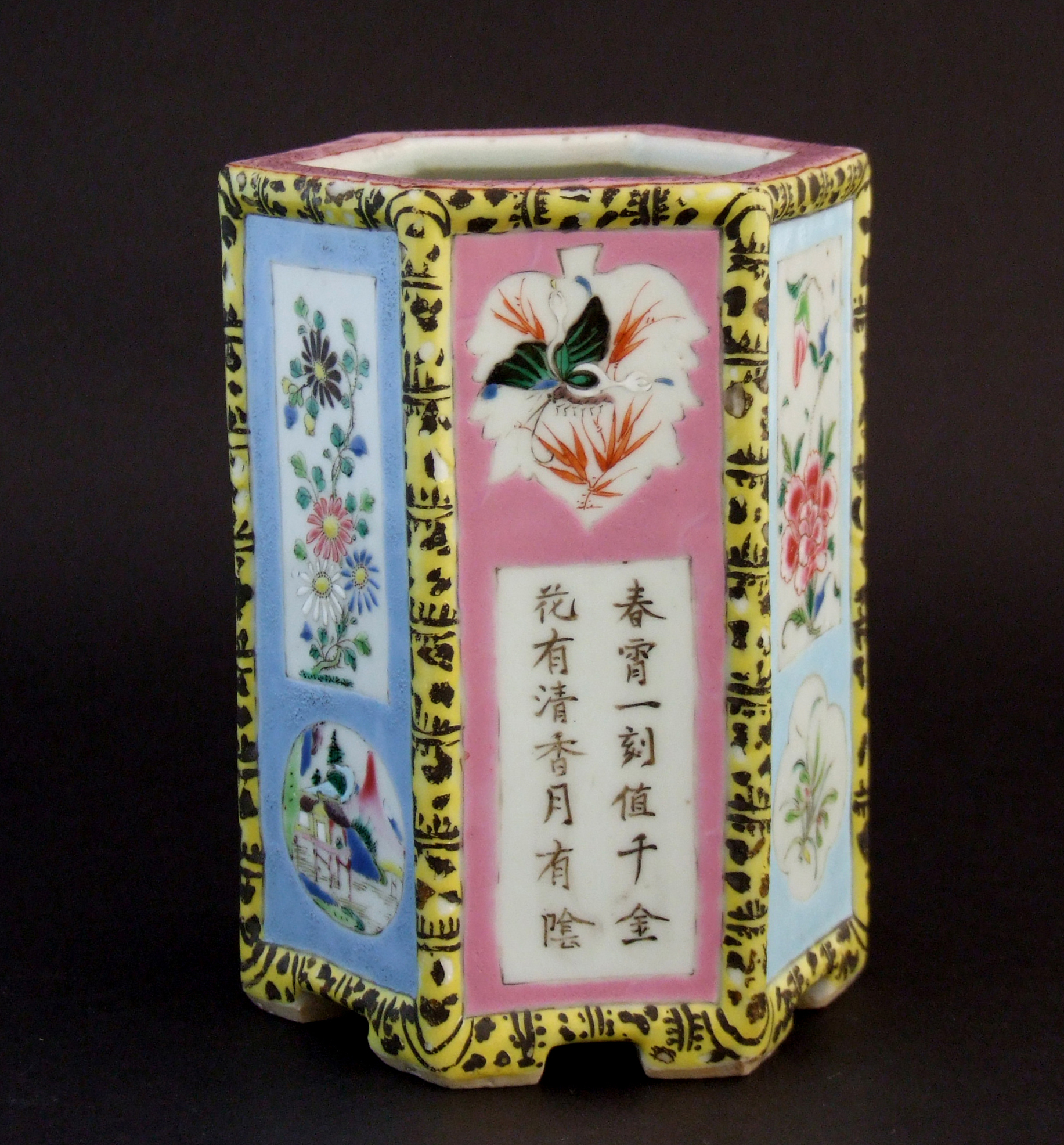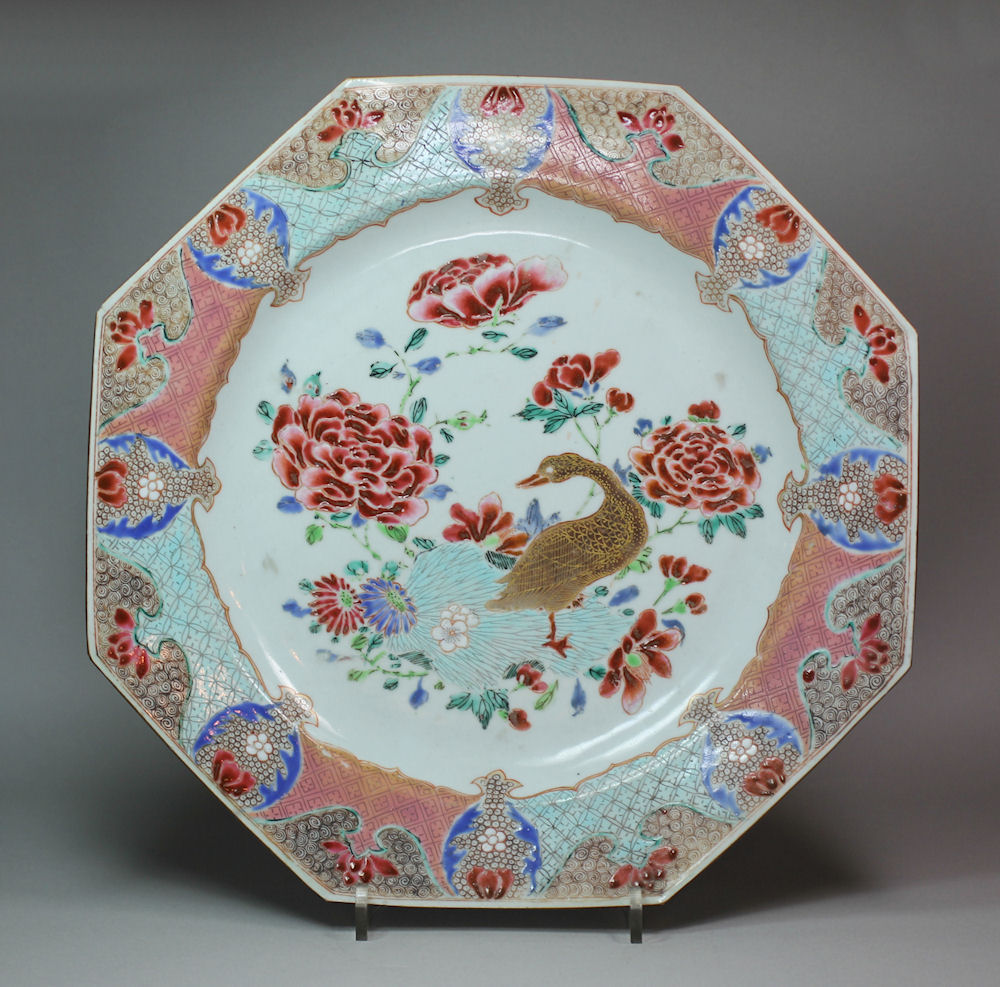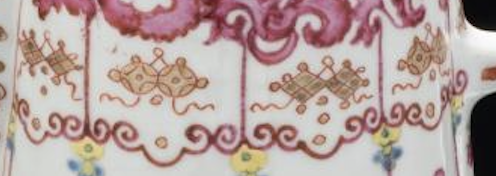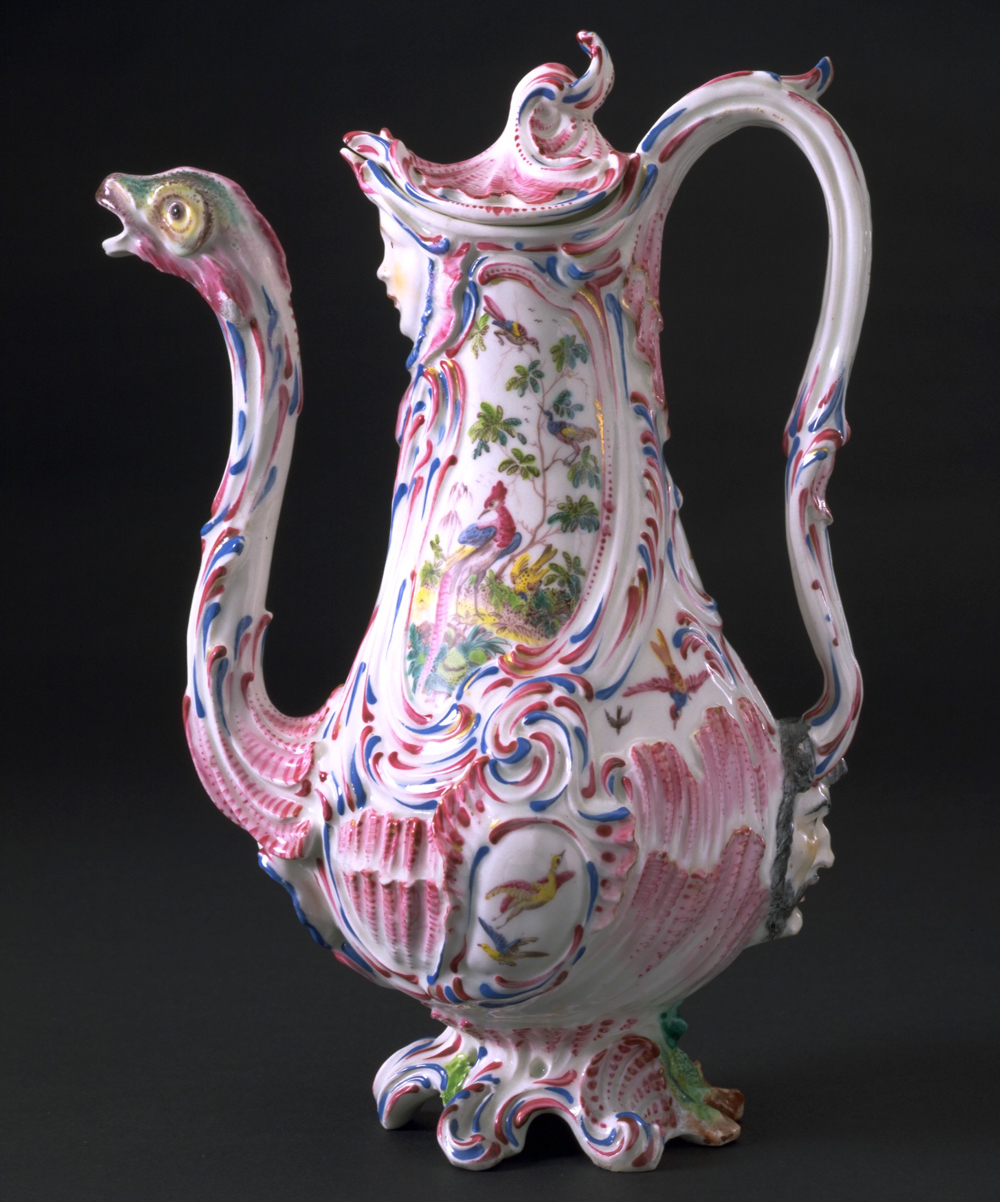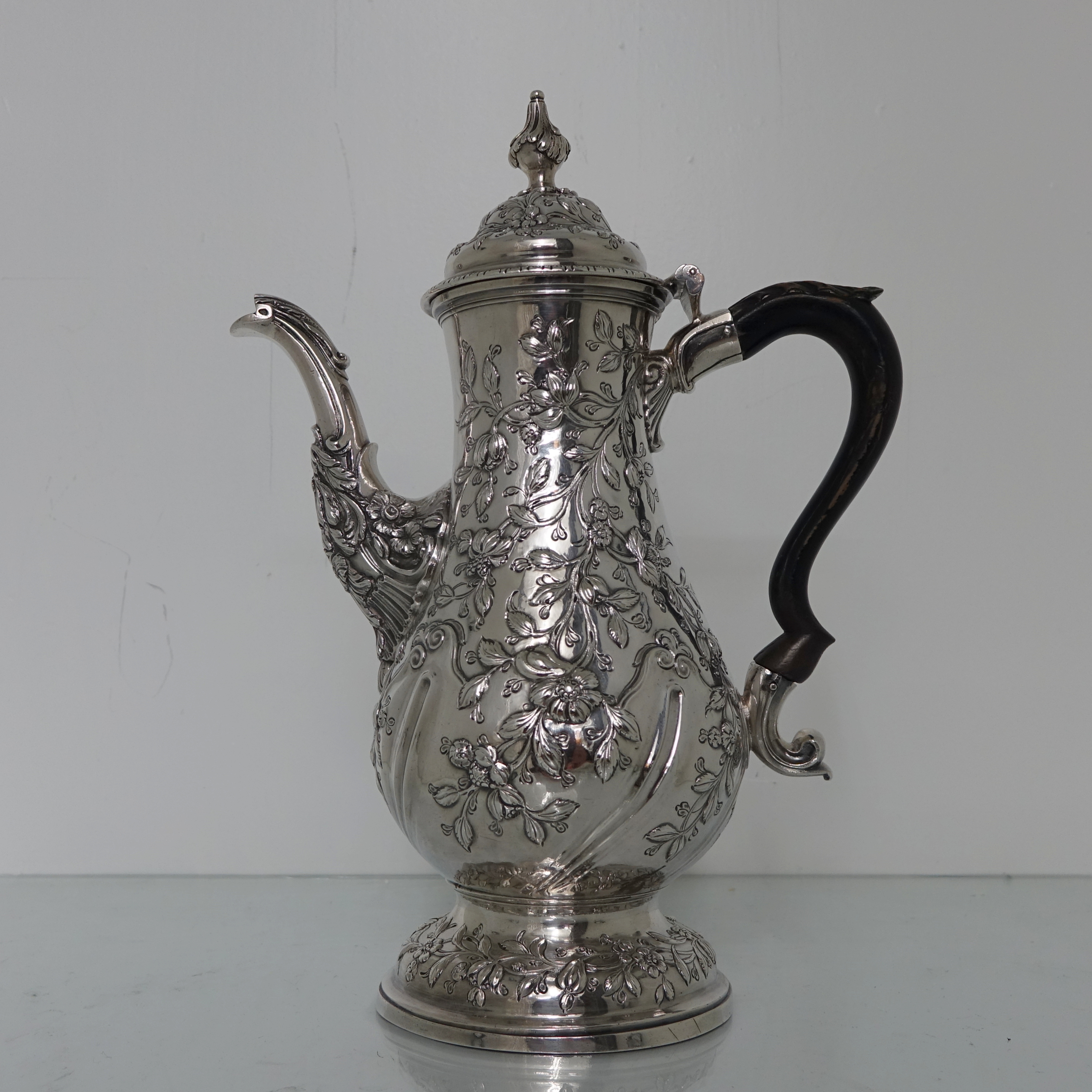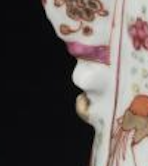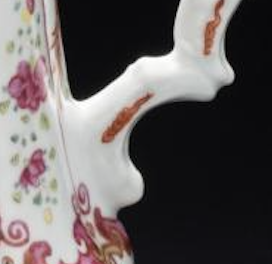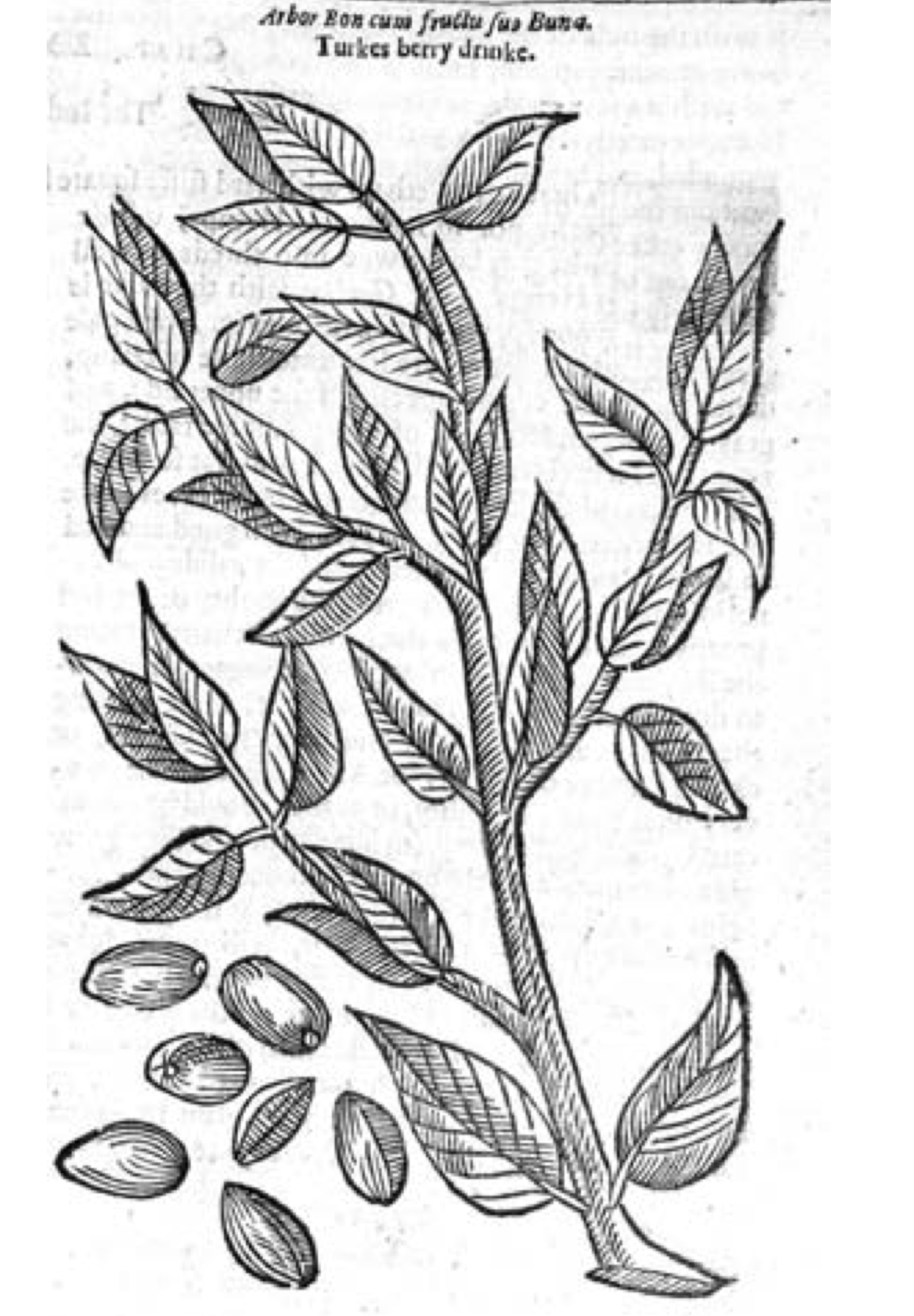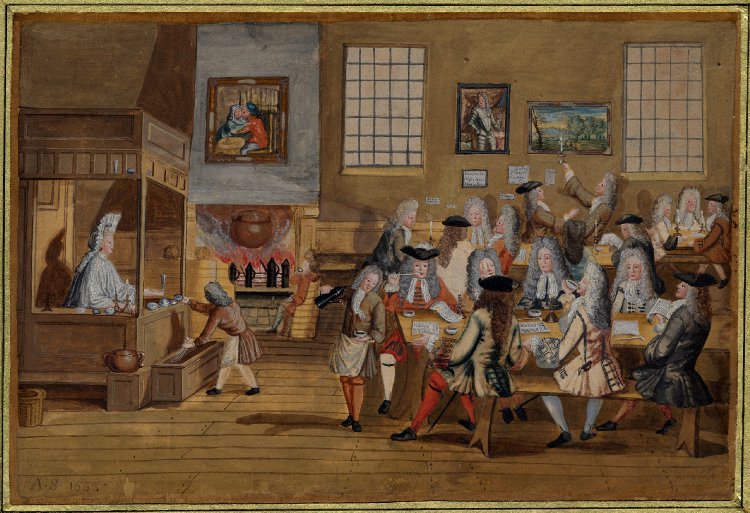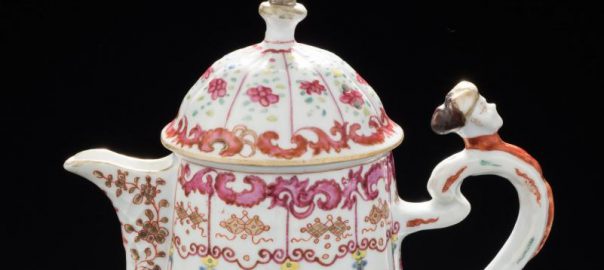CONTEXTUAL ANALYSIS ON THE VISUALS OF THE CHINESE COFFEE POT
- THE ELEMENTS
- FLOWERS
- LINES
- BOY
- LADY
- BIRD
- IMPERIAL MARK

I will begin the analysis of the painting by firstly trying to identify each elements then move on to find meaning and significance of those elements in the context of Chinese painting. Eventually, I wish to propose some narrative about the painting on the Chinese Coffee Pot.
FLOWER
I will begin with the main flower pattern which was painted on the body of the Chinese Coffee Pot. After researching through different possible flowers type and motifs of porcelain, I found that a possible pattern for this series is the Four Seasons. I will explain more on the Four Seasons before continue with the matching of each flower.
| FOUR SEASONS This decorative pattern is also called Four Flowers according to its floral motif. It appears on a variety of vessels forms, including large, medium and small bowl, serving dish, tea cup, wine cup, and spoon. Four kinds of flowers representing each season are distributed evenly on the surface of the vessels, with the image of a peach in the central part of the vessel. The flowers chosen by the porcelain painters are specified species representing each season. When the four flowers appear together on the porcelain, they stand for a complete circuit of four seasons and also conveyers of a full set of meanings auspicious to the Chinese. The Four Seasons is the most decorative kind in terms of its colourful appearance. On the other hand, the Four Seasons porcelain was more costly than others in the Chinese tableware market. Its colourful and relatively more elaborate decoration is one of the influencing factors for this higher price. It has a meaning of “May you wealth and fortune throughout the year”. |
|
Element |
Symbolic Meaning of Decorations |
|
Peony (spring). The king of flowers is the most popular botanical motif in Chinese art. The flowers are closely associated with royalty because they have been grown in imperial gardens since the Sui dynasty (581-618). It symbolises wealth and honour in the sense of high rank, having an official position, or high social status. Peony in a vase (the latter symbolises safety) means ‘may you have peace and prosperity’. |
Wealth and honour |
|
Lotus (summer). Popular theme in Chinese literature and art with the spread of Buddhism as symbol for purity and harmony. The symbolism of lotus is also derived from the puns that come from the Chinese pronunciation of its name, he hua or lian hua are both homophonous with the Chinese word for peace, union, continuity, and to link or connect. Therefore image of lotus is often combined with happy marriage and birth of children. Another name shui furong of lotus is a pun for wealth and honour hence lotus is also symbol of flourish and prosperity. |
Purity and harmony; peace, union, continuity; prosperity |
|
Chrysanthemum (autumn). With plum blossom is called Two Friends of Winter as both bloom when most flowers wither under the cold and frost winter winds. Ancient Chinese drank chrysanthemum wine on the ninth day of the ninth lunar month in order to prolong their lives. Chrysanthemum can also be used as medicine: people drink tea brewed from its petals, which helps to reduce heat and remove toxic substances in human body. |
Perseverance, longevity |
|
Plum blossom (winter). With chrysanthemum is called Two Friends of Winter as both bloom when most flowers wither under the cold and frost winter winds. Also, the plum blossom is also a sign of one’s safety. Ancient Chinese people would paint a plum blossom on envelope or letter itself, which announces peace and safety. |
Perseverance, longevity; safety |
|
Peach |
Longevity |
|
Endless knot |
Longevity |
The pattern repeats throughout. The flower at the lid might be peony or plum blossoms.

At the same time, it is also known that four seasons pattern usually accompanied with peach at the centre however there is no peach painting on the porcelain. However the knob at the top might seem like a peach. Maybe it has been the peach that is created to complete the four seasons while making it functional.
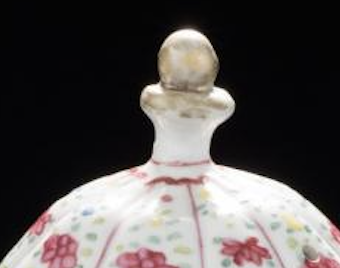
There are also leaves in different green surrounding the flowers. The leaves that looks like C shape might represent the acanthus leaf influenced by Rococo style. This type of leaf is only found at the bottom half of the body.

Also, the four seasons is said to be accompanied with endless knot to show that the season repeats and all the good things last for good. At this pot, there are pattern that looks like representing the endless knot at near the rim of the body. It is in gold colour and looks similar to endless knot.

Trying to find the meaning of the knot, the closes I could find from Chinese symbolical ornament is the eight precious things and the eight lucky emblems of the Buddhists. In particular, the shape seems close to
- number 3 of the eight precious things, meaning: probably one of the dual symbol the female)
- number 6 of the eight precious things, meaning: probably books
- number 8 of the eight lucky emblems of the Buddhists, meaning: Chang, an emblem of longevity
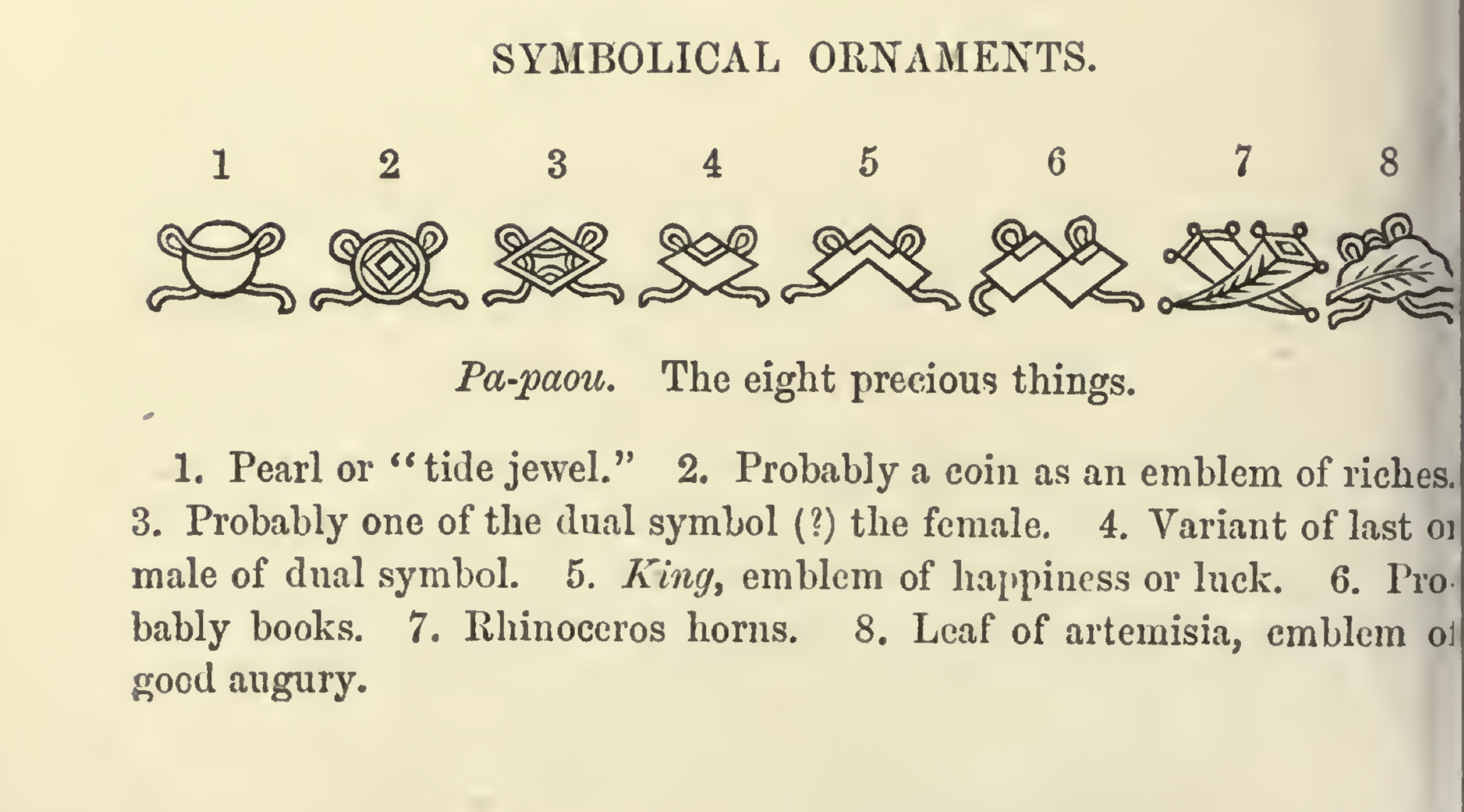

Therefore the flowers on the Chinese Coffee Pot may mean to carry the message of “May you wealth and fortune throughout the year” and that it will go on for good for the owner.
LINES
The vertical and horizontal dividing line of the coffee pot might be made in order to make it more relatable to the European market. It is made to make the coffee pot looks more familiar with European coffee pot during that time.
Firstly is about the pink vertical line of the pot. As the lines divide the coffee pot to 10 equal parts, its intention might have been to create copy and simplify the octagonal coffee pot in Europe. The octagonal designs coffee pot has been introduced in 1710.
Meanwhile, the horizontal line seems to be the painting version of festoons, a chain or garland (of flowers, leaves, or ribbons) hung in a curve as a decoration. The element of festoon on a coffee pot has been popularised during the Rococo era. At the same time, the shape of the festoon is made of the acanthus leaf which is one of the basic motifs of Rococo design. The shape of the leaf itself seems to be modified and made more stylised and Chinese on the coffee pot.
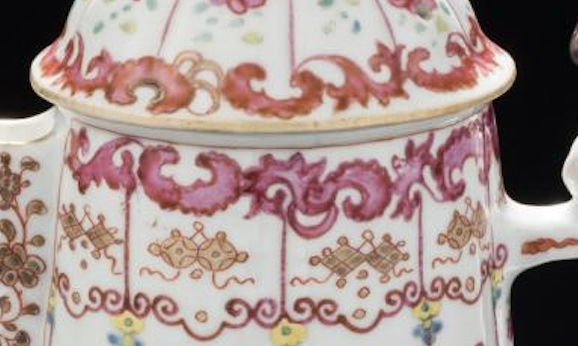 
|
Therefore, the line might have been made with the intention of giving some kind of visual illusion that represents the depth and shape of the coffee pots style in Europe. It seems like the lines were made with influence of European coffee pot style and demand during that time in order to make it more appealing in the European market.
BOYS
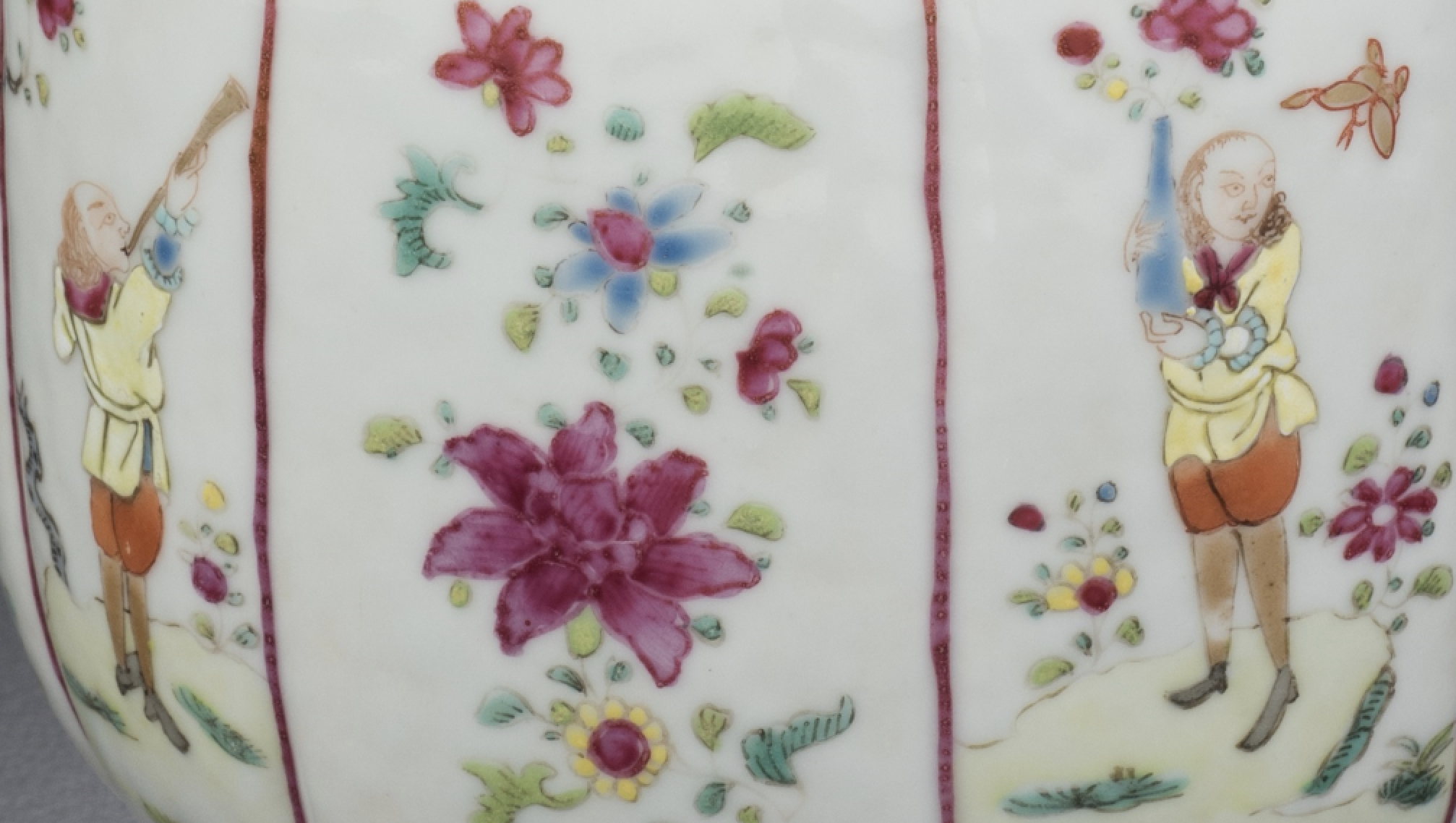
To begin analysing the boys on the coffee pot, I began by the first finding about the meaning of boys playing at garden through a activities pamphlet of Chinese porcelain.

From the pamphlet, a possible story for the boys in Chinese porcelain might be the ‘children at play’ which called a picture of babies at play or a picture of a hundred sons that symbolises numerous sons and happiness. Looking more about the term, I found vases that will help in telling the story of the boys on the coffee pot.

The primary decorative motifs on these vases are paintings of children at play in a garden. The subject is a variation of the popular “One Hundred Boys” motif that appeared on ceramics, paintings, and textiles in the eighteenth and nineteenth centuries. Because the birth of sons was highly desired in traditional Chinese culture, images of numerous boys at play were regarded as auspicious, and were often displayed around the New Year’s festival to bring luck in the coming year.
Both vases depict boys lighting firecrackers, a traditional New Year’s activity intended to scare away malevolent ghosts and spirits. Other passages show boys fishing, another common New Year’s subject, since the Chinese word for fish is homophonous with the word for abundance and prosperity. However, the fantastic garden setting, and the scenes of boys releasing mythical spirits and beasts from magic bottles, indicate a much broader theme than simple New Year’s wishes, namely the innocence and magic of childhood.
COMPARISON WITH COFFEE POT
After knowing about that, I may say that a possible narratives for the coffee pot is the related to the context of New Year’s Festival as well. One boy on the coffee pot seems to be blowing a trumpet in joyous gesture while the other one seems like holding a magic bottles, releasing mythical spirits and beasts. As the coffee pot was made around the same period as the vases, it is likely that the mindset of the people for children is that the birth of sons was highly desired and will bring luck to the family. Therefore, the narrative carry the innocence and magic of childhood as well as a message that having sons will bring good fortune.
However, there is one thing that distinct from the coffee pot boys, the boys are European, not Chinese! Comparing paintings of European and Chinese boys during 1700s, we can differentiate them from their hair colour, hairstyle and clothing.

| Chinese boy | European boy |
| Dark hair colour | Light hair colour |
| Chinese clothing with baggy long | European clothing with long coat and laces at the sleeves |
| Long or short loose pants | Knee breeches and hose |
| Chinese flat shoes | buckled shoes |
But why the boy is European? Maybe it is because of the targeted market of European market or it might be upon request by the patron. Another possible reason is to make it more appealing and relatable for the European market. In that way, the boy visuals may be a marketing strategy to make the coffee pot more appealing as it radiates the happiness and innocence of the (buyer’s) childhood. While at the same time believe to bring good fortune, for those who believe so.
LADY
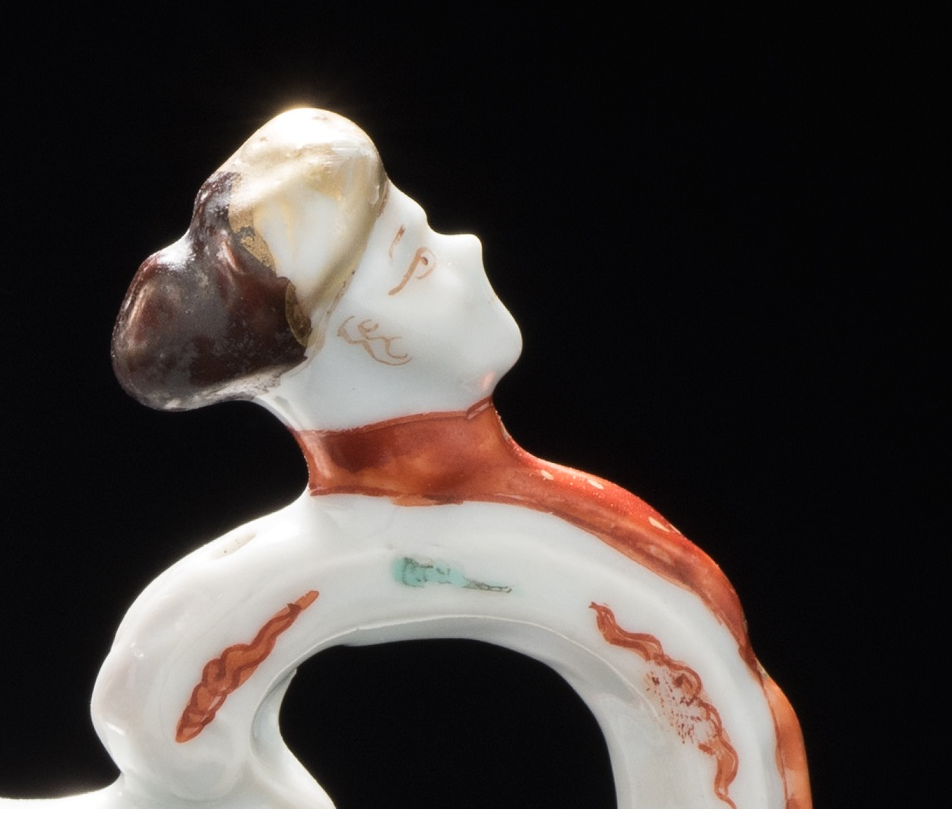
Another element is the lady head that might have served as the thumb-piece of the coffee pot. Comparing with the Chinese export porcelain figures of the same period, it is likely that the lady was made to be Chinese. It is apparent from the dark hair colour compared to the European lady (see the painting mentioned on previous part) of that time which mostly have light hair covered in wig. At the same time, the face shape and white color also indicate that the porcelain Chinese skin at the period was made to be white therefore it supports the claim that the lady is Chinese. However, the difference can be seen from the hairstyle of the lady. As the porcelain figures represent the hairstyle of court lady, the hair is bun up while the one on the coffee pot has lower hair bun. It might represents that the social status of the lady of coffee pot is lower than a court ladies, it is possible for the lady to represents commoners.

But again, why would the lady be a Chinese lady if the target market is European? Some possible scenario that I could think of is that the coffee pot might be targeted for Chinese ladies staying in Europe. But it is unlikely as the demand for coffee in China, so I assume for Chinese descendant in Europe as well, might not be that high for the cost producing such porcelain. Another scenario is that maybe the Chinese fashion and style was also a trend in Europe during that period, therefore it was made to appeal fashionable and cater the European market.
BIRD
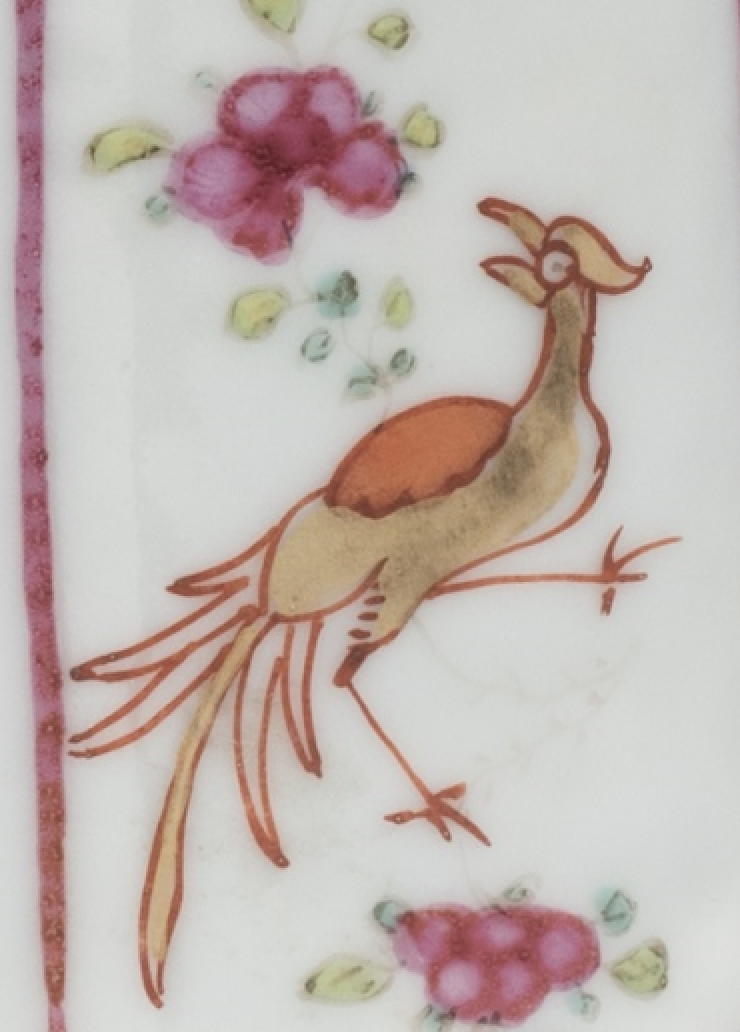
There are bird paintings on the top half of the coffee pot body. After browsing through many Chinese art, I was convinced that the bird represents phoenix. Comparing to the reference, the bird seems to have similar shape including its long tail, pointy headpiece, short beak and long feet. The only different was that the closed wings on the coffee pot.

PHOENIX
The phoenix is a sacred bird of Chinese mythology. The phoenix alone is a symbol of joy and peace believed to be the king of all birds and also a symbol of good fortune. As the second of Four Super Natural Creatures the phoenix has the head of a pheasant, the beak of a swallow, a long neck, multi-colored legs and the tail of a peacock. It symbolizes the sun, fertility, abundant harvest, good luck and longevity. During the Ming and Qing dynasties the Chinese phoenix was adopted as the symbol for the empress and charged with yin, the negative principle of the cosmos, while the dragon was selected as a symbol of the emperor and thought to be charged with yang, the positive principle of the cosmos
However, after further analysis and research and looking to more samples, I realised that the coloring and the posture of the bird do not really represents a phoenix that was commonly shown in Chinese porcelain. Usually, the phoenix will be shown flying with its long tail spread all over direction (usually upwards), often painted together with dragons. I had doubt whether it is a phoenix until I found a piece that convinced me that the bird on the coffee pot is not a phoenix but a pheasant instead. The porcelain has a pheasant perched on the branch of a peony tree surrounded by flowering peonies and aster.
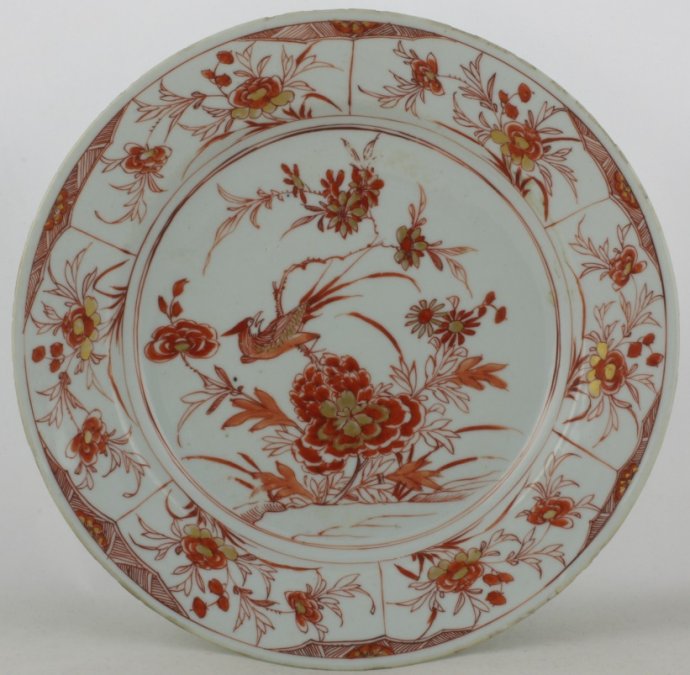
Finding a page of both phoenix and pheasant, I have set my view that the bird on the coffee pot represents pheasant. Apparently, phoenix was generally depicted with similarity to an ornamental pheasant. Observing the differences, I feel that the main different lies in the posture, tail and colour of the birds.
Phoenix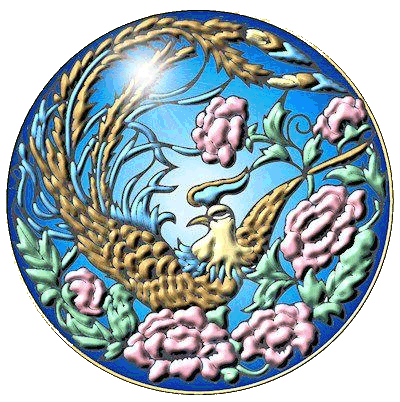 |
Pheasant
|
| tend to be portrayed while flying | as the animal prefer to walk than fly, they tend to be portrayed as perching on something or walking on the ground |
| the direction of the tail tend to be upwards with more complex details | the direction of the tail tend to be downward with simpler tail shape |
| the colour of the body parts varies from painting to painting, some of the wing colour shown to be similar with the other body part colour | the colour of the wing tend to be portrayed in different colours than other part of the body |
THE GOLDEN PHEASANT
As the headpiece of the pheasant is gold, it can be considered the golden pheasant or Chinese pheasant. Long tailed pheasants were popular on porcelain decoration. The pheasant is a very popular motif on Chinese export porcelain and frequently appears on enamelled and underglaze blue Kangxi wares. It also plays a rather prominent part in early Chinese literature. The bird was represented as standing on a rock, looking towards the sun, the imperial symbol of authority. In Chinese bureaucratic hierarchy officials of the second grade had a gold pheasant embroidered on their court robes, those of the fifth grade a silver pheasant. Pheasants are also strongly associated with women and is depicted as a general symbol of beauty, good fortune and refinement.
In conclusion, the golden pheasant might mean to bring beauty, good fortune and refinement for the coffee pot owner. At the same time, it might be a wish to gain promotion or authority. These wishes make the elements more meaningful to make the coffee pot more demanded and wanted in the market.
IMPERIAL MARK
At the time, Jingdezhen was producing famille rose porcelain which one might easily assume was being made for the nouveaux rich, were it not that some of them bear the nianhao of the emperor. Guyuexuan (meaning ‘Old Moon Pavilion’) is the name given to snuff bottles of polychrome enamelled glass and bibelots of enamel decorated porcelain of yongcai. However, the name was also given to the cups and vases of famille rose porcelain which were of exceptional quality and careful decoration. Painted for the Imperial palace between 1727 and 1754, the best pieces (small teapots, cups, pots, goblets etc.) are all delicately painted with poems written in black characters and framed in red seal script. The nianhao (Imperial mark) of Yongzheng is inscribed in a square on the base of the object, usually in blue, mauve or yellow ink.
Yongzheng Imperial marks in kaishu (left) and zhuanshu (right)
Da Qing Yongzheng Nian Zhi, translating as ˜Made in the Great Qing dynasty during the reign of the Emperor Yongzheng”(1723-1735).
MARK ON THE COFFEE POT
As the museum only show one side and top view of the coffee pot, there is a possibility of an imperial mark or even poem on the unseen part. The imperial mark of YongZheng night be found at the bottom of the coffee pot and written in either kaishu or zhuanshu. Also, if there is a poem on the other side, that means that the coffee pot was considered as one of the best pieces produced.

ADDITIONAL VISUAL OBSERVATIONS
The top half of the pot is having Chinese elements while the bottom half has European element. The Rococo style use the colour of gold with some consideration in mind, in this coffee pot the colour of gold is only used at the top half, where the Chinese elements are on. Is it meant for some relationship between China and Europe to be implied? Is the Chinese implicitly saying that they are of higher position (literally) and are better (gold) than the European?
[Additional information on the Golden Peasant]
FACTS
The following part is shared as it was my first time knowing the existence of golden pheasant, and I am fascinated and would like to share a bit more on this animal.
- Early records indicate the Golden pheasant was imported from China to England and Europe around 1735.
- Adult males may grow 90-105cm in length, with the tail being approximately two-thirds of its total body length.
- The golden crest, rump and rich red body make it unmistakable; few birds look this exotic. The crest of the male is golden-yellow with a hint of red at the tip.
- The Golden Pheasant feeds on the ground on grain, berries, leaves, grubs, small insects and other vegetation.
- They roost in trees at night.
- They are fast on the ground and prefer to run rather than fly, but if startled they can suddenly fly upwards with a distinctive whirring of wings.

Previous part: CONTEXTUAL ANALYSIS ON THE VISUALS OF THE CHINESE COFFEE POT
Next part: CONCLUSION
SOURCES AND REFERENCES
- “A Special Exhibition of Porcelain with Painted Enamels of Yongzheng Period in the Qing Dynasty_Court-Style Type.” 國立故宮博物院. Accessed November 06, 2018. https://www.npm.gov.tw/exh101/yongzheng/en/ch02.html
- “Asian Art.” We Are All Writers Now / Oberlin Alumni Magazine / Spring 2011. Accessed November 06, 2018. http://www2.oberlin.edu/amam/ChineseVases.htm.
- “Bird Symbolism in Chinese Art 鸟 Niǎo.” History of Relations between China and Japan. Accessed November 06, 2018. http://www.chinasage.info/symbols/birds.htm.
- “Chinese Porcelain.” Pater Gratia Oriental Art. Accessed November 06, 2018. https://www.patergratiaorientalart.com/home/2258.
- “Chinese Porcelain Marks.” Marks on Chinese Porcelain – Ming Dynasty (1368-1644) Reign Marks. Accessed November 06, 2018. http://gotheborg.com/marks/qingmarks.shtml
- Chow, Fong. “Symbolism in Chinese Porcelain: THE ROCKEFELLER BEQUEST.” Accessed November 6, 2018. https://www.metmuseum.org/pubs/bulletins/1/pdf/3258464.pdf.bannered.pdf
- Kang, Siliang. “Symbolic Meanings of Chinese Porcelains from the Market Street Chinatown.” Accessed November 6, 2018. https://marketstreet.stanford.edu/wp-content/uploads/2013/08/Kang-2013.pdf
- Irv. “Irv.” Buy Chinese Antiques. September 17, 2017. Accessed November 06, 2018. http://www.chineseantiques.co.uk/yongzheng-emperor/
- Nilsson, Jan-Erik. Marks on Chinese Porcelain – Ming Dynasty (1368-1644) Reign Marks. Accessed November 06, 2018. http://gotheborg.com/glossary/phoenix.shtml
- Person. “Demystifying Chinese Reign Marks – Everything You Need to Know to Get Started | Christie’s.” Albrecht Dürer: 10 Things to Know | Christie’s. April 25, 2017. Accessed November 06, 2018. https://www.christies.com/features/Reign-marks-on-Chinese-ceramics-An-expert-guide-8248-1.aspx
- Person. “Say It with Flowers: An Expert Guide to the Symbolism of Chinese Ceramic Decoration | Christie’s.” Albrecht Dürer: 10 Things to Know | Christie’s. April 26, 2018. Accessed November 06, 2018. https://www.christies.com/features/A-guide-to-the-symbolism-of-Chinese-ceramic-decoration-9163-3.aspx.
- “SANTOS.” Chinese Export Porcelain Sauce Tureen and Stand after an English Creamware Shape, C. 1790, Qianlong Reign, Qing Dynasty. Accessed November 06, 2018. http://www.santoslondon.com/chinese-porcelain-details.asp?stockID=372.
- “The Golden Pheasant in Chinese Culture and Tradition.” TerraFirmaTourist. November 05, 2014. Accessed November 06, 2018. http://www.terrafirmatourist.com/the-golden-pheasant-in-chinese-art-and-culture/.
- “The Hidden Meaning in Chinese Design at Our Places.” National Trust. Accessed November 06, 2018. https://www.nationaltrust.org.uk/features/the-hidden-meaning-in-chinese-design-at-our-places.
- “1700–1750 in Western Fashion.” Wikipedia. October 16, 2018. Accessed November 06, 2018. https://en.wikipedia.org/wiki/1700–1750_in_Western_fashion#/media/File:Philips_Charles_Group_Portrait_Of_A_family_By_A_Lake_And_A_Classical_Pavilion_detail.jpg



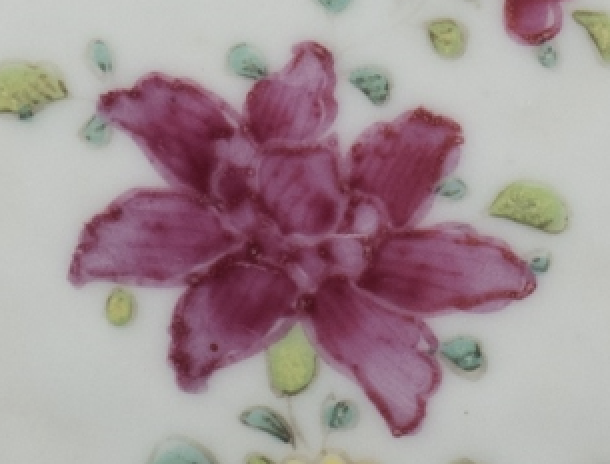
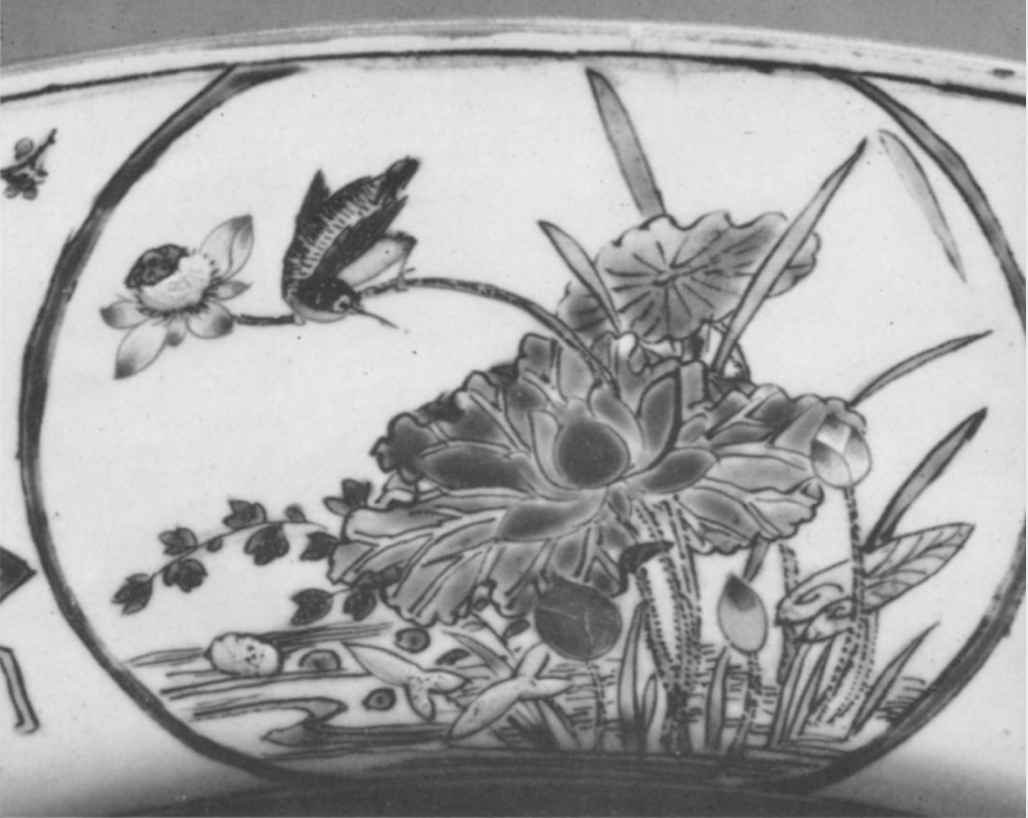
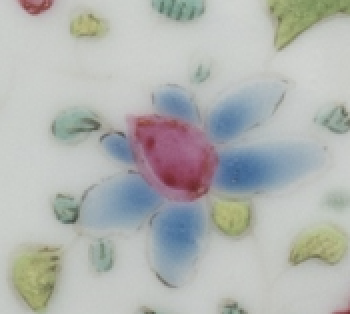
.jpg)


